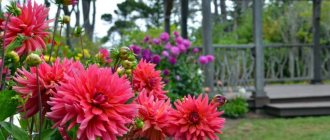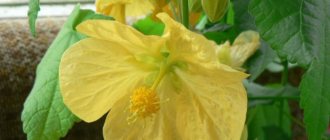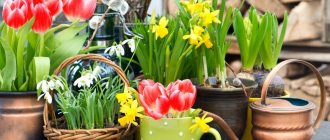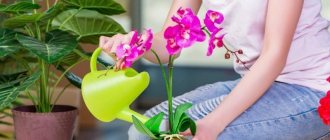A bright bouquet and indoor flowers will decorate any interior. And so that you learn to care for them not from your own mistakes, we asked florists Alena Gaidunkova, Irina Yudina And Elena Popova talk about basic recommendations for caring for flowers.
In this article we will tell you:
- How to care for indoor flowers?
- How to care for ficus?
- How to care for a cactus?
- How to care for violets?
- How to care for the flower of happiness?
- How to care for a money tree
- How to care for aloe?
- How to care for lilies?
- How to care for chrysanthemum
- How to care for gerberas
- How to care for tulips?
- How to care for cloves?
- Flower care cheat sheet
How to care for indoor flowers?
Basic care for indoor plants includes 5 steps:
- Watering. Use a watering can with a long spout. When watering, it should touch the edge of the pot. Pre-settle the water for at least 3 hours.
- Spraying. To create a warm shower, prepare a spray bottle and settled water.
- Trimming stems and removing dust from leaves. Wipe off dust from large leaves with a damp sponge, and from small and pubescent leaves with a brush. Trim stems with garden shears.
- Feeding . Choose liquid or dry fertilizers. The former are more often used for feeding indoor plants, since they provide the fastest feeding of the root system.
- Transfer. Replant a flower only if it is sick or has grown out of the pot. Plants do not like frequent replanting.
Floristry courses
online
Floristry courses
in Moscow
Floristry courses
In Petersburg
How to fertilize at home
When studying information on how to care for any indoor plants, you should specifically focus on feeding. Under natural conditions, plants receive everything they need from the soil, whose mineral composition is independently renewed. It is impossible to reproduce the natural cycle in the house. Therefore, fertilizing is carried out with special compounds.
Important : it is better to add less fertilizer than to add it in excess.
Mineral compounds are most easily absorbed - they contain pure salts, which is very good for plants living indoors. The nuance is that in their pots there are often few bacteria that ensure complete processing of organic matter.
Mineral fertilizers can be simple, that is, containing only one substance (phosphate, potassium or nitrogen), and multicomponent. In complex preparations, the composition is often enriched with microelements such as sulfur, magnesium or calcium. The presence of the latter is usually not important, since their flowers can be obtained from soil or water.
There are specialized complex fertilizers for all main types of plants - these are the ones you should choose.
So, in particular, compositions where the following prevail:
- nitrogen - suitable for deciduous ornamental crops;
- phosphorus - beautifully flowering;
- potassium - for succulents.
Minerals intended for feeding orchids have a low concentration.
Important: strictly follow the dosage recommended by the manufacturer of the drugs - excess leads to soil salinization.
The second category includes organic fertilizers. They are made from raw materials of animal or plant origin. In fact, this is a semi-finished product that is digested slowly, as it must also be processed by bacteria. The number of the latter is ensured by special preparations that are introduced along with fertilizing. The most affordable and effective way to fertilize home flowers is to water them with tea leaves.
An overdose of organic matter is rare, but a large volume of it provokes an abnormal growth of the population of certain microorganisms, which can be unsafe.
In addition, it is very difficult to maintain the correct balance with such drugs. Typically, these formulations lack potassium, which means it will have to be added separately.
There are also combined (humic) mineral-organic mixtures. Products are produced based on humus, peat, or sludge treated with alkaline, acid or saline solutions. This type of fertilizer is more easily absorbed than purely organic fertilizer and slower than mineral fertilizer.
The general rules for applying fertilizers are:
- a month before the onset of the dormant period, portions of fertilizers begin to be reduced, and after the flower awakens, they are gradually increased;
- Before adding the nutrient composition, the soil is moistened;
- It is better to feed in small doses, but often (for example, with each watering);
- new fertilizers are applied in minimal doses - this allows you to make sure that they are suitable for the flowers.
How to care for ficus?
Ficus is one of the plants that do not like frequent rearrangements and transplants. It is important to grow it in the same place.
In summer, the comfortable temperature for the flower is 23-25 degrees Celsius, in winter 18-20 degrees Celsius.
Rules of care:
- Water your ficus deeply and regularly as the soil dries out.
- In summer, give the flower a warm shower.
- In winter, wipe off dust from the leaves.
- Feed the plant only in spring and summer, when the flower is gaining green mass. Organic or mineral fertilizers are suitable.
How to care for a cactus?
Cacti require a lot of sunlight. Place them on the south or east sides.
Winter is a dormant period for most cacti. Therefore, during the cold season, move it to a cool room and place it in the shade. In summer, take the plant out onto the balcony.
For watering, use water at room temperature. In summer and spring, water the cactus once every 2 days. In autumn, once every 5 days. And in winter, once every 1.5 weeks.
The warmer the room, the more often and more abundantly the cactus needs to be watered.
Some tips from experienced flower growers
Each plant has its own care card, which describes the requirements for structure, soil fertility, and pH.
When the plant is hot, the temperature can be reduced by spraying or moistening the soil. However, water droplets in the sun turn into lenses that burn through the leaves. An electric humidifier will help - it supplies cold steam in the form of mist.
If the plant has withered, it is better to move it into the shade, shade it with a curtain, and water it lightly. In order for the bush to grow its crown evenly, it must be turned toward the light evenly.
In winter, the window sills are cold. In order for the roots to work, the planters must be placed on stands. The spring sun is aggressive. All shade-loving flowers moved towards the windows should be moved deeper into the room.
Purchased plants are kept in quarantine for 2 weeks, away from other flowers. Then the soil in the pots needs to be changed and filled with the recommended soil. Observe the plant. If necessary, feed after 1.5-2 months.
How to care for violets?
Violets should not be placed on the south side, where there is a lot of sunlight. The leaves will easily get burned and the plant will die.
The optimal temperature for a flower is 20 degrees Celsius. Violet is afraid of drafts and cold.
Rules of care:
- It is better to water the violet not from above, but through a tray, so as not to get on the rosette of the flower. The plant needs watering 1-2 times a week.
- You cannot spray violets.
- The plant should be fed only when it is in flower. Young violets need nitrogen fertilizers, and adult specimens need phosphorus-potassium fertilizers.
Variety of indoor plants
All indoor plants are hybrids or dwarfs, resulting from centuries of selection. They were trained to live in a compact bowl and the flowering effect was enhanced. Indoor flowers are demanding in terms of maintenance conditions. They can be friendly, solitary, contain poison, or produce toxins. Knowing the biological characteristics of each representative of the flora, you can get a spectacular composition of healthy plants in your apartment.
Based on the totality of their decorative properties, indoor flowers are described as:
- Deciduous
– bush forms with showy leaves, vines without flowering – ivy, ficus.
- Blooming
– with roots in the form of panicle bulbs, in a fertile substrate – daffodils, violets, anthurium.
- Flowering potted (succulents)
– zamioculcas, orchid – resilient, not requiring a special microclimate.
- cacti
– a separate group of plants, distinguished by the structure of the ground part, including flowering and non-flowering forms.
- Miniature indoor flowers
- the work of breeders who turned ordinary plants into dwarfs. Among them are Saintpaulia, ferns, kalachoe, gloxinia, roses. The plants are low, less than 15 cm, and the flowers are large and beautiful.
For home maintenance, it is important to know the general appearance of an adult plant. Based on this criterion, they determine its place in the apartment, or refuse to purchase it. Some of the indoor flowers reach two meters in height and grow in width; they belong in the hall or office foyer.
Some plants can live in the shade with minimal lighting, while others can live in a south-facing window. Many people are tolerant of winter ventilation; for some, a blast of fresh cold air is a killer.
Bulbous flowers delight with long-lasting flowering buds of unusual beauty and shape. But they love warmth, moisture and a lot of sunlight. There is a place on a wide windowsill - clivia, villota, amarcinum will become decorations.
It is not easy to come across a bonsai tree. Exotic is an ordinary tree grown in cramped conditions using special methods of crown formation. They grow a work of art for decades and sell it at a high price. If you need a quick result, choose a lemon tree - a beautiful crown, vitamin-rich fruits.
You can decorate the walls with hanging plants hanging in pots. A fast-growing, flowerless vine, cissus has grape-shaped leaves. Fuchsia, surfinia, and hoya are blooming.
If you choose indoor flowers with large leaves, it is better if the leaf has a two-color pattern or an inflorescence of extraordinary beauty. The favorite plants of many indoor gardeners are the money tree and Decembrist.
A large group of indoor flowers are miniature forms - dwarf Saintpaulias (miniature violets) or miniature Kalanchoe. Minirose is as beautiful and fragrant on the windowsill as its garden sister in the flowerbed.
There are thousands of indoor plants. From the presented assortment, everyone can choose a flower, then another, and arrange a relaxation corner in the apartment. At the same time, it is important to collect plants in one zone that are compatible with care conditions.
How to care for the flower of happiness?
Some of the most frequently purchased flowers are Spathiphyllum and Anthurium . People call them female and male happiness.
Spathiphyllum grows in nature along rivers. Create a humid and cool climate for it. The temperature should not exceed 22 degrees Celsius.
The flower does not tolerate sun or strong shade. The eastern or western side is optimal for it.
Rules of care:
- Spray 3-4 times a day.
- Water with settled, non-chlorinated water at room temperature.
- Feed with special fertilizers. In summer every 2 weeks, in winter every 3-4 weeks.
For the anthurium , choose any place; it does not have to be placed on the windowsill. He will like even the high temperature in our apartments in winter. But at the same time it is necessary to create sufficient humidity for the plant.
Rules of care:
- Spray only the leaves twice a day. No moisture should get on the inflorescence.
- Water once every 4 days exclusively with settled water.
- Once a month, fertilize the anthurium with organic, mineral or complex compounds.
Temperature and light
Home care must be correct. Atmospheric conditions have a huge impact on plants. Flower growers are constantly trying to understand the environmental factors that can significantly affect growth and flowering.
Temperature influences flower photosynthesis and also plays a role in seed germination. If it falls outside the required range, the seed will not germinate.
Temperature is one of the most important factors. Not many plants will develop well in normal indoor conditions; for some, special conditions need to be created.
Almost all indoor flowers are suitable for temperatures of 13–24 degrees. Cold air helps slow down physiological and biochemical processes.
Not only is photosynthesis reduced, the plant does not receive enough air and cannot distribute organic matter, as a result of which it dies.
All living organisms are particularly influenced by light. It regulates the daily rhythm of physiological processes. The correct light regime is very important in the life of indoor flowers.
If the flower does not receive enough of it, it stops growing. Shoots appear, but become thin and leaves small. Over time, he dies.
For a flower to grow, it needs to receive at least 12 hours of light per day. In winter, the length of the day becomes shorter, which means plants do not grow as actively during this period.
How to care for a money tree
The money tree is a plant of the Crassulaceae family. Its leaves look like coins.
Caring for a money tree is easy. The main thing for him is moderate watering, periodic feeding and crown formation.
Trim mature plants to create a decorative appearance. There are several options:
- To obtain a plant with a thick stem, remove all shoots and lower leaves.
- For a classic tree, trim off any excess side branches.
- To get a lush shrub, get rid of the side leaves, but do not remove the shoots.
The trunk is always cut above the fourth pair of leaves.
Rules of care:
- Crassula does not like abundant watering. In summer, water the plant once a week, in winter once every 2 weeks.
- The flower does not require regular spraying. It is enough to wipe the leaves with a damp sponge.
- In summer, feed the plant once every 2 weeks, in other seasons once a month. Liquid fertilizers for cacti or succulents are suitable.
Shade-tolerant flowering indoor plants: photos and names
This is a section dedicated to flowering indoor plants (with photos and names) that thrive in shaded conditions. For many plants of that group, bright light is destructive.
Balsams (lat. Impatiens)
The perennial shade-tolerant plant is considered a godsend for lovers of unpretentious care and bright flowering. The stems are erect, somewhat transparent and succulent. The leaves reach 10-12 cm, can be toothed, lanceolate or oval, green or purple-bronze. There are hybrids with variegated foliage.
The handsome plant blooms from early May to December with flat corollas (4 cm) with spurs. There are double flowers with a wide range of colors, excluding blue and yellow.
It is necessary to water abundantly and maintain the air temperature at 20 degrees.
With regular feeding twice a month, the plant can reach 60 cm in width and height. However, there are also low-growing varieties.
ADVICE!
If you want to leave the balsam after flowering, it is better to renew it by cuttings.
Streptocarpus (lat. streptocarpus)
A shade-tolerant flowering herbaceous beauty that blooms in the warm season with funnel-shaped flowers of various shades. Flowers are located on long peduncles. The leaves, depending on the variety, can grow up to 2 or up to 35 cm and are collected in rosettes. The leaf of the plant is oblong, matte, green, corrugated and covered with fluff.
In summer, Streptocarpus loves shade. Features of watering include a small amount of water in summer (twice a week) and sufficient water in winter (every 8-9 days).
ADVICE!
It is better to spray the air around the plant with water.
Streptocarpus grows up to 30 cm in width and the same in height. Lifespan: 3 years.
IMPORTANT
The plant reacts negatively to tobacco smoke!
Clivia cinnabar (lat. clivia miniata)
This plant has a massive rhizome and is considered stemless because its hard, belt-like leaves resemble a fan spread around the rosette. The leaf length varies from 30 to 50 cm. Clivia blooms in February and until April you can admire its red-orange or yellow flowers. An umbrella inflorescence of 12 funnel-shaped flowers is located on a thick, long peduncle.
Clivia
Clivia cinnabar thrives in partial shade or dim light.
This plant is perfect for those who sometimes forget about watering their plants: they prefer to drink clivia once a week, and at the end of autumn even once a month. But even during flowering there is no need to flood the flower!
Plant height is 50-60 cm, sometimes more. It’s great that the lifespan is long, about 15 years.
IMPORTANT
The plant will bloom only when wintering at 9-10 degrees.
Of course, in our list of shade-loving indoor plants you did not see all the names and photos, but chose the most common and easy to care for.
How to care for aloe?
Aloe is a light-loving plant. Feel free to place it on a south window and do not hide it from the sun's rays.
In summer, take the plant out into the fresh air. In winter, the flower has a rest period. During this time, keep it in a cool place.
Rules of care:
- Water the plant immediately after the top layer of soil has completely dried. Avoid getting moisture into the leaf rosette, otherwise the plant may rot.
- The plant does not need to create a special microclimate. There is no need to spray it.
- Feed the flower monthly from spring to autumn. Any mineral fertilizers will do.
Photos and names of indoor bulbous plants
Daffodils (lat. narcissus)
These beautiful early flowers are associated with spring. They can be grown both at home and outside.
Narcissus
The leaves are very long, although depending on the variety they can be 15 cm or 60 cm. The leaf itself is long and erect with a slight concavity. The flowers are white or yellow, located on a long flexible peduncle, one or several at a time. The flower itself looks like a crown surrounded by 6 lobes.
Today, varieties of pink and even orange flowers have been developed. Daffodils love direct sunlight. Watering during flowering should be plentiful, and after that it is better to keep the plants dry. After flowering, it is better for the plant to move to the garden. In a pot, the daffodil will not exceed 50 cm in height.
Hippeastrum (lat. hippeastrum)
It will decorate any room with both long fleshy arched leaves up to half a meter and 2-4 flowers on a long peduncle. The diameter of the flowers is large, reaching up to 15 cm. Color options: pink, white, carmine-red, two-color.
Hippeastrum
Hippeastrum flower
Flowering duration does not exceed 3 weeks. It is better to place the pot in a place near the window, without direct sunlight hitting the plant. Hippeastrum is not picky about water; it is enough to water it lightly once a week.
ADVICE!
Feed the plant from the moment the buds appear until the foliage turns yellow once every two weeks.
After all the leaves turn yellow, the hippeastrum is transferred to a cool, dark room for 2.5-3 months, and then replanted.
How to care for lilies?
Lily can stay at home for up to 2 weeks. Prepare a vase for her with settled water and add an antiseptic. An aspirin tablet, activated carbon or a few crystals of potassium permanganate will do. This will prevent the flower from rotting.
Change the water in the vase daily, rinse the stems and leaves under running water.
Remove the stamens from blooming flowers, then they will bloom much longer. A bouquet of lilies will be best preserved indoors at room temperature, away from sunlight.
Feeding and fertilizers
Strong, healthy and flowering plants cannot be obtained without the use of fertilizers. Growing takes a lot of time and effort, flowers are a wonderful creation of nature to decorate the room, and they are worth all the effort you put in.
You just need to know how to properly care for them in order to get a beautiful flowering plant at the end.
When caring for house flowers, it is important to know what, how and when to feed them. There are a huge number of fertilizers, but choosing the best is difficult.
Fertilizing should be used if the stems and leaves become thin, flowering or growth has stopped.
How to care for flowers in terms of using fertilizers:
- Use black tea. Dry tea leaves are added to the pot. Thanks to it, the soil becomes looser and lighter.
- Coffee grounds saturate the soil with microelements. It increases its acidity, so it is recommended to use for hydrangeas and azaleas.
- To help orchids, violets and other indoor flowers grow better, use orange or lemon peels. They should be crushed, placed in a jar and poured with boiling water. After a day, the solution can be used for feeding. Excellent for blue hydrangea. It is recommended to use this fertilizer once a month.
To promote flowering, water the plants with a fertilizer-stimulating composition.
Use them in accordance with the instructions, do not overdo it, as this can destroy a living organism.
You can buy succinic acid in the store. This fertilizer is diluted with water. 5 g per 1 liter is enough. Succinic acid literally pulls plants out of the dead, but it can only be used once every 5 years.
How to care for chrysanthemum
Start caring for cut chrysanthemums by cutting the stem with a knife along an oblique line. Remove the lower leaves.
Stagnation of water should not be allowed. Change it at least once every 2 days.
When changing the water, add one of these products:
- A specialized drug that is sold in florist shops. For example, "Bud".
- Aspirin. For 2 liters of water, 1 tablet is enough.
- Salt. 2 teaspoons per 2 liters of water.
- Granulated sugar. 2 tablespoons per 2 liters of water.
Chrysanthemums love cool rooms with temperatures up to 20 degrees Celsius and do not tolerate direct sunlight.
Trimming
Circumcision should only be performed in certain cases. This is an important point in flower care, and very individual.
In what cases is a plant pruned?
- dry parts must be removed;
- Compact plants must be maintained;
- there are deformed shoots;
- rejuvenation required;
- Sanitary pruning is carried out if the flower is sick.
This procedure is not as complicated as it might seem at first. To do this you will need to use pruners or scissors.
Trimming rules:
- When a shoot is completely removed, it should be cut back to the very base.
- If pruning is necessary so that the plant begins to grow and bush, trim so that a bud and 5 mm remain on the shoot.
- If symmetry is broken, remove unnecessary parts.
- Also prune shoots that grow towards the trunk.
- The cut needs to be disinfected. Sprinkle them with sulfur powder.
This procedure weakens the plant and it may begin to hurt. Don't be scared, just take action. Strengthen the flowers by feeding them.
How to care for gerberas
Cut gerberas last from 7 to 14 days with proper care.
First, distribute the bouquet. Be careful, the flowers have fragile and thin stems. Their tips should not touch the bottom of the vase.
Cut the stem along an oblique line with a sharp knife, this will increase the supply of moisture to the plant. The water in the vase should cover the stems by 4 cm. When it evaporates, it is necessary to add liquid.
Clean and trim the stems every 3 days. To do this, rinse the ends of mucus under running water.
To disinfect, add a few granules of citric acid or an activated carbon tablet to the water.
Replanting an indoor flower
- Remove the plant from the store-bought container to avoid damaging the roots. An hour before transplanting, water thoroughly. Do not pull on the stem; turn the pot over, supporting the surface of the soil and the root zone with your hand. Wiggle the bottom of the container so that the bush gently lowers to the table surface. Lightly shake off the earthen ball.
- If the root system has grown too much, trim the ends with pruning shears. Sprinkle the sections with crushed activated carbon tablets to prevent infection.
- Prepare the pot, add drainage. Fill the container halfway with soil.
- Place the flower in the middle. Carefully fill the sides with soil up to the edge of the pot. Lightly compact the soil with your fingers. The entire stem should be above the soil surface.
- Water when the air pockets disappear and the soil settles. If necessary, add soil mixture. The root head should be underground.
- Place the pot in the chosen place and do not disturb it for several days. Replanting is always a shock for an indoor flower.
- Haircuts for medium hair with bangs: women's hairstyles with photos
- Neurologist - what does the doctor treat?
- How to deal with depression and apathy on your own
How to care for cloves?
For a bouquet of carnations, choose a vase with a wide neck so that the flowers are not pressed tightly against each other. The water level should be 10-15 cm.
Sweet water will help extend the life of the bouquet. Add 70 g of sugar to 1 liter of liquid and stir thoroughly.
Place the flowers in a shaded area and spray them daily.
If you want to learn not only how to properly care for flowers, but also how to create flower arrangements, sign up for a florist course. They are suitable for both those who love to create beauty at home and those who dream of mastering a sought-after profession.
To choose a teacher, look at his portfolio with ready-made compositions. The work must be done carefully and you like it.
In floristry courses you will learn:
- basics of flower arrangement;
- modern techniques for composing a bouquet;
- product packaging;
- storage of fresh flowers.
Choose courses that include the cost of flowers, packaging, frames and decorative elements to create displays. It will be cheaper than buying practice materials yourself.
At the end of the course, you will be given a certificate confirming that you are a young and promising florist.
How to plant an indoor flower
Growing plants from seeds, cuttings or babies has its own subtleties. Before planting an indoor flower, you need to pick up a pot and pour boiling water over it to disinfect. Be sure to use drainage. Expanded clay, vermiculite, and small crushed stone are suitable for this. The drainage material provides ventilation for the roots and protects them from rotting.
It is important to choose the right soil and take into account the lighting of the room. A new indoor flower is planted in moist soil.
Choose the right pot
One of the mistakes novice gardeners make is using the wrong utensils. The size, shape and material of the pot are of great importance. Plastic is suitable for moisture-loving indoor flowers. Clay and ceramic walls of containers allow air to pass through. Because of this, moisture evaporates faster from pots that are made from natural materials.
For flowers that do not require frequent watering (succulents) or have small roots, a bowl is suitable - a wide, low vessel. When replanting, choose a new container 2–3 cm larger than the previous one. When buying a pot, keep in mind that 1/3 of the volume will be filled with drainage. Place a large pot for indoor flowers immediately in a suitable place - once filled with soil, it will be difficult to move the plant.
The hole at the bottom of the pot is necessary for the drainage of excess water after watering.
To maintain a certain style in the interior, many gardeners use flowerpots. This is a decorative container without a hole in the bottom. You can put any unsightly pot inside. If the basic rules are followed, otherwise, when purchasing a container, rely on your taste and budget.
Requirements for the soil mixture
A special subtlety in floriculture is the correct composition of the soil. The structure and acidity (pH) of the soil mixture play a key role in the proper development of flowers. It is dangerous to fill pots with soil from the garden and yard. There may be larvae of harmful insects, spores of dangerous fungi.
Ready-made soil mixtures have a balanced composition - they contain peat, moss, and vermiculite.
Store soil is loose and light and quickly absorbs water. The acidity level must be indicated on the substrate packaging. Universal soil has an average pH of 6.
Chlorophytum, asparagus, and adenium grow well in alkaline soil. Hydrangea, rhododendron, and ceropegia love acidic substrates.
You can buy ready-made soil for succulents, palm trees, and flowering plants. If you don’t know what soil acidity you need, purchase a universal mixture. The soil from the store contains fertilizers. Caring for indoor flowers is simplified - for about six months after transplanting, they will not need feeding.
Flower care cheat sheet
The main thing is to provide the flowers with the proper microclimate.
Find out the most complete information about your plant:
- where to put it;
- how often to water and spray;
- when and what to feed.
Cut plants will last longer if they change the water daily, trim the stems and feed them with a mixture for bouquets, which are sold in every flower shop.
Follow the rules of care, and then the flowers will delight you for many years.
Do your indoor flowers survive? What products do you use to extend the life of your bouquet? Write in the comments about your knowledge and experience. Repost so you don’t lose the article and read it over the weekend.
This training may be right for you:
- 10 Best Online Floristry Training Courses
- Best Floristry Courses in Moscow from 1,300 Rubles
- Best Floristry Courses in St. Petersburg
Tip 4: Feeding flowers with food waste
Do not forget that indoor plants need to be fed with fertilizers periodically. It is not at all necessary to use commercial chemicals, since everything we need is in our home.
Flowers can be fed with milk, but the main thing is not to overdo it, otherwise the soil will acquire an unpleasant odor. To 1 liter of settled water I add 1 teaspoon of milk and shake everything well, adding it to the root. You can also use whey, or the liquid after squeezing the cottage cheese: 2-3 teaspoons per liter of water.
Feeding indoor flowers with milk
This fertilizing will enrich the soil with nitrogen, potassium, calcium, sulfur, phosphorus, magnesium, copper, manganese and iron. Cacti and succulents do not tolerate it well, so I do not recommend fertilizing them with milk water.
Garden crops also love feeding with milk; you can read about this in this article.
You can also water your indoor plants with the water you used to wash the meat.
The use of castor oil is recognized by scientists and gardeners as an excellent growth and flowering stimulator for plants. To prepare the solution you will need 1 liter of water and 1 teaspoon of castor oil. Before watering, you need to shake vigorously and water the flowers during the development of leaf buds and budding.
Castor oil for feeding flowers
In winter I water the flowers with sweet water. I also got this advice from my grandmother. Sugar water replenishes plants' lack of sunlight. Everyone knows that sugar breaks down into fructose and glucose.
The second component is very beneficial for plants. Glucose serves as a source of energy for plant life processes - absorption of nutrients and water from the soil, oxygen and moisture from the air. Also, it is a building material that serves for the formation of organic molecules.
I prepare the sugar solution by dissolving 1 tbsp. l. Sugar for half a liter of water. You can also simply sprinkle the soil with granulated sugar in a flower pot, and then water it with settled water.
Both garden and home crops can be fed with yeast; read about this in the article.











